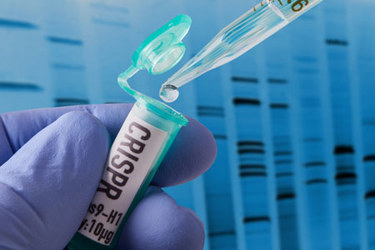The Outlook For Gene Editing In The U.S.

By Erin Harris, Editor-In-Chief, Cell & Gene
Follow Me On Twitter @ErinHarris_1

Gene editing has evolved over the past several years, and 2023 could be a truly pivotal year. Vertex Pharmaceuticals’ and CRISPR Therapeutics’ exa-cel, which has been developed to treat sickle cell disease and beta-thalassemia, could be approved this year in both the U.S. and E.U. Indeed, all eyes are on the advancement of gene editing as well as prime editing and base editing. To get a true understanding of the current and near-term outlook for gene editing, I caught up with Mike Lehmicke, Vice President, Science and Industry Affairs, Alliance for Regenerative Medicine (ARM). Here’s what he had to say.
It has been over a decade since CRISPR was first discovered. How has gene editing impacted the cell and gene therapy sector?
Concerning the cell and gene therapy industry, CRISPR has contributed to the clinical advancement of gene editing, which has reached a ‘coming of age’ moment. The ZFN and TALEN techniques set the early foundation for gene editing and were the dominant approaches in clinical trials until about 2018.
At that point, the number of CRISPR trials overtook the earlier approaches. Our data through the end of 2022 show that out of 140+ gene editing clinical trials globally, 100+ use CRISPR while 40+ use TALEN, ZFN, or other gene editing methods.
CRISPR has also proved to be a versatile tool that can be used in multiple therapeutic approaches. Developers have been studying how CRISPR can improve immuno-oncology applications such as CAR-T, Natural Killer, and other cell therapies.
This can come in many forms, but common examples include using the platform to improve the effectiveness of engineered cell therapies and advance allogeneic cell therapies.
Will we soon see CRISPR therapies approved to be used in the U.S.?
They may soon become available for patients, which is a big step forward from five years ago when most trials were in the early stages of development. The first would be exa-cel, which Vertex Pharmaceuticals and CRISPR Therapeutics developed to treat sickle cell disease and beta-thalassemia. The therapy could receive a regulatory decision from the U.S. FDA in late 2023 (and a decision in the E.U. within months).
If approved, it will greatly increase the patient population that can be treated by a gene therapy. An estimated 100,000 people are living with sickle cell disease in the US. About 32,000 patients with this severe disease across the US and Europe will form the target population for the therapy, which is far higher than those for other rare genetic disease therapies approved by FDA. Those patient populations range from the hundreds to the low thousands.
What does the current clinical pipeline look like?
One of the most exciting aspects of CRISPR, and other gene editing techniques, is how they can redefine how we treat various diseases. They have the potential to be curative in a single dose, but they can also potentially expand the number of conditions we can target.
Several treatments are in the Phase I/II stages of clinical trials in the US, with all signs pointing towards blood disorders as defining the first generation of CRISPR gene editing therapies. This is demonstrated by not only exa-cel but also Editas Medicine and Graphite Bio, which also use CRISPR gene editing to develop therapies that treat sickle cell disease and beta-thalassemia.
There are a variety of other CRISPR therapies in the Phase I/II stage of clinical trials in the US, aiming to transform medical care for other conditions.
Some examples within this category include Intellia Therapeutics’ treatment for ATTR amyloidosis, a protein-folding disease, and Editas Medicine’s treatment for Leber congenital amaurosis, a genetic eye disease that causes blindness. These are in vivo treatments, which deliver the genes directly to a patient’s cells inside the body. Excision Biotherapeutics is also conducting a clinical trial to develop an HIV cure through CRISPR gene editing and treated its first patient in 2022.
Now that CRISPR is here, what do the next few years look like?
We have only just begun to realize the potential of gene editing. Most of the current clinical pipeline in the US uses CRISPR to make double-stranded breaks in the DNA sequence. As the sector continues to innovate, more advanced forms of gene editing are emerging to improve accuracy and efficiency. They can potentially help us address a broader range of conditions, including prevalent ones.
Base editing can change individual DNA and RNA letters in a sequence by ‘nicking’ the DNA strand instead of creating a double-stranded break. This process allows for precise modifications to DNA and is already in the clinic. Verve Therapeutics has a base editing therapy in phase I trials in New Zealand and the UK to treat Heterozygous Familial Hypercholesterolemia, a common cause of heart disease. Beam Therapeutics also has a base editing therapy for sickle cell disease in phase I/II trials in the United States.
Looking further out, are there even more advanced techniques on the horizon?
Prime editing is currently being explored in early clinical research. Like base editing, prime editing also ‘nicks’ the DNA strand. What differentiates it is that it can address all 12 types of base pair modifications of the DNA, and the technique can potentially correct up to 89% of known genetic variants associated with human disease.
While there is still much to be understood about the potential of prime editing, early studies have shown that it can be used to correct mutations that cause different forms of liver disease. Researchers are also exploring how it can be applied to other diseases like spinal muscular atrophy, cystic fibrosis, cataract disorder, and Wilson disease.
Epigenetic editing, on the other hand, is being investigated as a way to control gene expression. This technique has been explored over the past decades and is starting to reemerge as a viable practice thanks to recent technological advancements.
How does it differ from the previous forms of gene editing that we discussed? The technique allows for multiplex editing with a theoretically lower risk of off target editing. Epigenetic editing is also switchable, meaning that it can provide a greater level of control over silencing specific genes.
The technology is still in the early forms of exploration, and only a few companies have even identified diseases they would target in their studies. Epic Bio, for example, has outlined plans to study how the technique can treat high cholesterol, liver disease, muscular dystrophy, and genetic vision loss. Chroma Medicine recently released studies in May demonstrating efficiency in using epigenetic editing techniques through its platform PCSK9 and hopes to advance a broader pipeline of potential therapies in the near future.
What’s the outlook for gene editing technology to reach patients?
I would pay particular attention to two areas that could be barriers to this technology – regulation and access.
When a scientific field advances quickly, it can be challenging for regulators to keep pace. The risk of this happening in gene editing would mean that the review of therapy candidates in the pipeline could reach a standstill.
The FDA has made efforts to keep pace with the rapid developments in gene editing. In 2022, the agency released industry guidelines titled “Human Gene Therapy Products Incorporating Human Genome Editing; Draft Guidance for Industry.” ARM commended the effort to help guide developers designing gene editing therapies while noting our feedback in our published comment letter.
We should also encourage talented individuals to seek careers with regulators like the FDA. As the agency brings on more staff to join the Office of Therapeutic Products, recruiting a talented pool of individuals can ensure that it’s ready to take on the coming wave of new gene editing therapies in the pipeline.
We also must recognize that our healthcare system is set up to treat the symptoms of diseases. It is not ready to embrace one-off treatments that can potentially cure diseases. While there has been some progress – including movement in Congress around the Medicaid VBPs for Patients (MVP) Act – much more needs to be done, especially as gene therapies, including gene-editing therapies, seek to treat larger patient populations.
 About the Author:
About the Author:
Michael has over 20 years of R&D experience in biomaterials, medical devices and regenerative medicine. He has led product development teams for class II devices, human cell and tissue-based products, and drug/device combination products. He is a creator and an inventor with multiple U.S. patents to his name.
